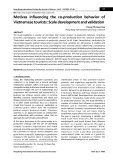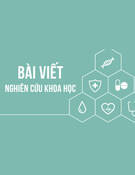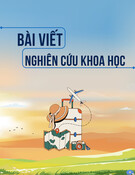
Motives influencing the co-production behavior of Vietnamese tourists: Scale development and validationTruong Thi Xuan DaoHong Bang Internaonal University, VietnamABSTRACTThe study highlights a number of incenves that impact product co-producon behavior, including: economic, psychological, and social movaons. It was developed from the research framework "Descripve model of the consumer co-producon process" by M. Etgar. Nevertheless, parcularly for travel-related goods, defined measurement scales for these variables are sll lacking. A credible and dependable scale measuring the social, psychological, and economic factors influencing co-producon behavior through a conceptual approach is needed to close this study gap. Muldimensional ideas become essenal and significant. From an operaonal standpoint, tourist managers can assess or track the success of co-producon techniques using measuring scales as a reference. The main purpose of this research is to develop a measurement scale for the group of psychological moves, economic moves and social moves that influence tourists' co-producon behavior. With this goal, the techniques implemented for measuring these concepts will follow the guidelines of including the following steps: 1) Idenfy topics (Churchill, 1979)and create categories; 2) Screening and correcon; and 3) Validate the scale.Keywords: psychological movaon, economic movaon, social movaon, co-producon behaviorToday, the relaonship between businesses and customers is no longer just a normal exchange relaonship between sellers and buyers but has changed according to the new market structure. It is structured through the axis of relaonships and cooperaon with customers and businesses [1]. A business can achieve success when it correctly idenfies customer requirements and needs and designs products that match customer expectaons or in other words businesses focus on a business model that focuses on customer sasfacon or customer-centric rather than the tradional product-centric business model. Customer centricity is an approach based on collaboraon and relaonships with customers rather than an approach focused on sales and profits [2].At this me, businesses in this sector adopt a co-producon strategy with the aim of idenfying complex customer requirements and needs precisely, providing a product that is cohesive with the customers to reduce service problems and grow service output [3]. Applying a co-producon strategy to the tourism sector is crucial for the success of the industry, understanding the indefinable needs of new potenal tourism products and organizing appropriate tourism acvies for customers '[4]. In order to understand the movaons that influence tourists' behavior to parcipate in co-producon is necessary. However, unl now, research on this issue is sll limited. Developed from the research framework “ Descripve model of the consumer co-producon process” [5], the study idenfies a number of moves that influence co-producon behavior such as: economic, psychological and social moves. However, measurement scales for these factors have not yet been clearly established, especially for tourism products. To fill this gap in research, developing a reliable and valid scale that measures the economic, psychological, and social drivers that influence product co-creaon behavior through a conceptual approach is essenal. Mul-dimensional concepts become necessary and important. From a praccal perspecve, measurement scales can serve as a guide for tourism managers to evaluate or monitor the effecveness of strategies in co-producon. 37Hong Bang Internaonal University Journal of ScienceISSN: 2615 - 9686 DOI: hps://doi.org/10.59294/HIUJS.VOL.5.2023.547Hong Bang Internaonal University Journal of Science - Vol.5 - 12/2023: 37-48Corresponding author: Dr. Truong Thi Xuan DaoEmail: daottx@hiu.vn1. INTRODUCTION






















